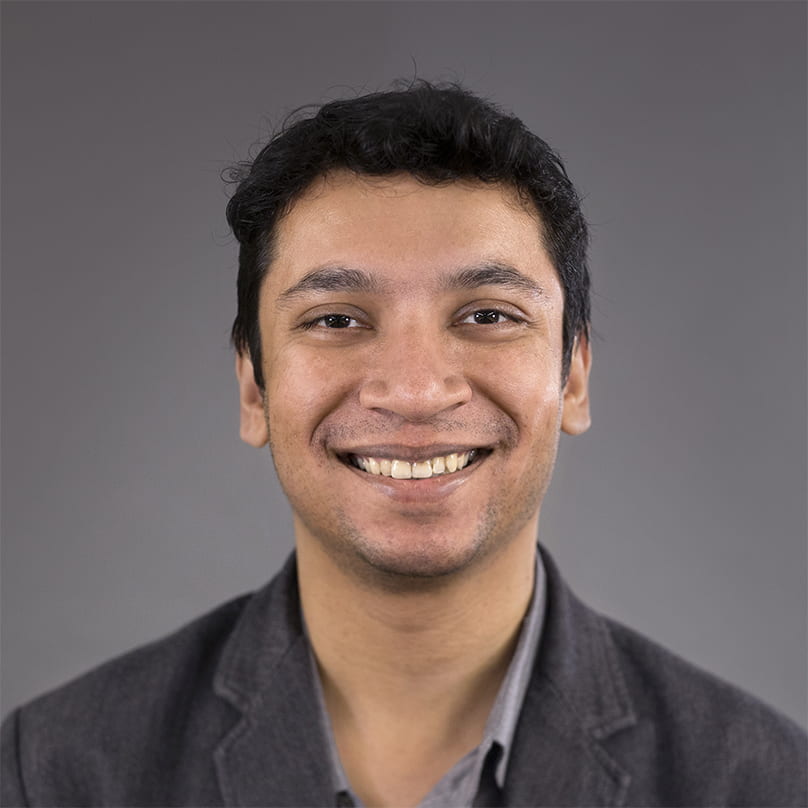In the 1950s, interior decorating magazines talked about the television as just another piece of furniture. Now your television follows you around, along with your phone, your stereo, your bookshelf, your mailbox, and a record of everything you do on them.
This semester, Rahul Mukherjee has been teaching two classes on digital media and its underpinnings: Television and New Media and Mobile Phone Cultures. At a time when many are binging TV and TikTok during stay-at-home orders, and the classes themselves are being conducted online, how does the Dick Wolf Associate Professor of Television and New Media Studies teach digital media?
“I like to move away from just the screen of the smartphone or the television set to talk about the environmental impact of data centers supporting streaming services and the so-called “flexible labor” or “informal labor” issues concerning rideshare and food delivery apps,” says Mukherjee, who is also an associate professor of English. “I think it's good to help my students to think and map some of these connections as they ask questions about these media, or contemplate and reflect on living with them.”
The class has covered cyber cultures, the internet, social media, misinformation online, the gig economy, global use of mobile phones, and the platforms required. They’ve also talked about the infrastructures needed for cloud computing services, like data centers and optical fiber cables, as well as the energy they require and their environmental footprint.
Mukherjee says he needs to work to keep up with his students, most of whom grew up with smart phones. Some are even micro-influencers on Instagram or Twitter. Every year when he teaches the television class, he asks students to name their favorite show and he rarely gets repeat answers. “There is no one single show or even group of shows that rise to the top; the television landscape is very diffuse.”
The course material in Television and New Media ranges from I Love Lucy to reception of Netflix in international contexts. “This is one class where they have to get a sense of what's happening across the vast media landscape and make connections,” says Mukherjee. Throughout, they’ve discussed how race and gender are represented on television. When they got to new media, Mukherjee asked them to also think about aspects of distribution and concerns about differential access.
This is one class where they have to get a sense of what's happening across the vast media landscape and make connections.
“These platform companies are creating a new kind of media landscape by labeling everything as content: film, a sound file, a music file, a TV show, a game,” he says. “And what these platforms do is curate the content for us, and one has to subscribe to them in a certain way, which leads to a particular kind of distribution economy.”
Both classes have spent a lot of time on the algorithms that curate content, how opaque they are, and the idea of surveillance. When navigating sites like Netflix or Hulu or Prime Video, Mukherjee says, “Some of the students feel like they're actually being somewhat controlled in a way, negotiating that tension between having control over what we watch, and being led into something.”
Before taking the Mobile Phone class, “I looked at my phone in a way that was the tip of the iceberg, but underneath, there's just a whole underbelly of actors that are able to basically see what you're doing,” says Alekso Miller, C’22.
Like many, Miller started using TikTok—an app that lets users share short videos—more during quarantine in March. “But we talked about how one of the reasons that it is so popular is because once you log into the app, they're tracking every video you're watching, how long you're watching it for, what type of video it is, what category, so they can recommend videos that you're going to want to keep watching to make it very addictive.”
Discussions of social media included how dating apps are now a routine part of the students’ social lives, and whether selfies on Instagram are superficial, commercial, or self-expression. They’ve talked about the expertise and labor needed for a popular image, and who the audience is.
“All of us, whether it's a politician, a corporation, a social movement, or as individuals, we both need and desire a certain amount of privacy and not wanting to be surveilled, but at the same time, also want publicity and attention of people, sometimes not for ourselves, but for issues that we think are important,” says Mukherjee. “So, how does one work out that conundrum on social media?”
Priyanka Pardasani, LPS’21, a student in the television class, manages online media for Penn Engineering. She comments on cancel culture, making a distinction between posts taken out of context and “something truly awful,” and the positives and negatives of influence culture. “It has really made me realize just how fragile we are when we are public online, and how careful we really do need to be,” she says.
Pardasani and Miller both like the globalism of the courses, which cover which digital media are popular and how they’re used around the world. In Mobile Phone Cultures they’ve discussed how people in China and India have used phones to create a flexible labor force and an informal economy. The television class heard from Heli Tiirmaa-Klaar, the Ambassador for Cyber Diplomacy of Estonia, that the country’s data is almost entirely digitized. That surprised Pardasani, given recent history in the U.S. with Edward Snowden and the Patriot Act. “Estonia has done a really good job of earning its citizens' trust and that has allowed them to do more digitally and allowed them to make life in Estonia a little bit more seamless.”
Miller, who took the class in an election year because he was interested in misinformation in the news, (popularized as “fake news”), found that it’s not just an American issue. “I thought it was interesting to take a course on mobile media cultures because so much of our lives and all of those topics, especially surrounding the election, kind of converge on the phone,” he says. “We talked about how in Brazil right now, they're having a very similar issue with misinformation being spread over WhatsApp, similar to how we have problems with misinformation being spread on Facebook.”
It’s a lot to take in in just one semester. “I try to explain that they should not forget that one sometimes needs to, at a very micro scale, try to understand one particular shot or a scene. But at the same time, think about the macro-scale of media infrastructures, and about the economics and politics of media entertainment distribution,” says Mukherjee. “I do lose myself sometimes kind of ruminating on the enormity of it all.”
He calls his students “avid and very skillful social media users,” though, good at seeing the balance of pros and cons of new media. Mukherjee says, “They keep mentioning the possibilities of freedom, and they also, I think, have a kind of healthy skepticism.”
“This course has shown me how there's so much interconnection between social media and journalism and data privacy that I kind of see that the stakes are a little bit higher than maybe we realize,” says Pardasani. “Once something is on the internet, it truly can live there forever.”




